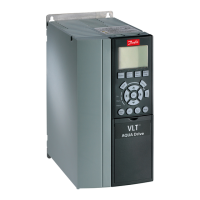NB!
When Freeze output is active, the frequency converter cannot be stopped via a
low ‘start [8]’ signal. Stop the frequency converter via a terminal programmed
for Coasting inverse [2] or Coast and reset, inverse.
[21] Speed up Select Speed up and Speed down if digital control of the up/down speed is desired (motor poten-
tiometer). Activate this function by selecting either Freeze reference or Freeze output. When Speed
up/ down is activated for less than 400 msec. the resulting reference will be increased/ decreased
by 0.1 %. If Speed up/ down is activated for more than 400 msec. the resulting reference will follow
the setting in ramping up/ down parameter 3-x1/ 3-x2.
Shut down Catch up
Unchanged speed 0 0
Reduced by %-value 10
Increased by %-value 0 1
Reduced by %-value 11
[22] Speed down Same as Speed up [21].
[23] Set-up select bit 0 Select Set-up select bit 0 or Select Set-up select bit 1 to select one of the four set-ups. Set
par. 0-10
Active Set-up
to Multi Set-up.
[24] Set-up select bit 1 (Default Digital input 32): Same as Set-up select bit 0 [23].
[26] Precise stop inv. Prolongs stop signal to give a precise stop independent of speed.
Sends an inverted stop signal when the precise stop function is activated in par. 1-83
Precise Stop
Function
.
Precise stop inverse function is available for terminals 18 or 19.
[27] Precise start, stop Use when Precise ramp stop [0] is selected in par 1-83.
[28] Catch up Increases reference value by percentage (relative) set in par. 3-12
Catch up/slow Down Value
.
[29] Slow down Reduces reference value by percentage (relative) set in par. 3-12
Catch up/slow Down Value
.
[30] Counter input Precise stop function in par. 1-83
Precise Stop Function
acts as Counter stop or speed compensated
counter stop with or without reset. The counter value must be set in par. 1-84
Precise Stop Counter
Value
.
[31] Pulse edge triggered Edge triggered pulse input counts number of pulse flanks per sample time. This gives a higher
resolution at high frequencies, but is not as precise at lower frequencies. Use this pulse principle
for encoders with very low resolution (e.g. 30 ppr).
[32] Pulse time based Time based pulse input measures the duration between flanks. This gives a higher resolution at
lower frequencies, but is not as precise at higher frequencies. This principle has a cut-off frequency
which makes it unsuited for encoders with very low resolutions (e.g. 30 ppr) at low speeds.
VLT
®
AutomationDrive FC 300 Operating
Instructions
4 How to Programme
MG.33.AG.02 - VLT
®
is a registered Danfoss trademark
61
4

